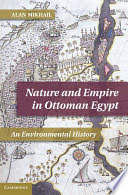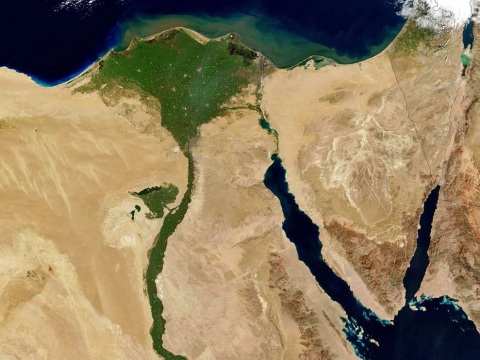Last year I published a review of Alan Mikhail’s Nature and empire in Ottoman Egypt in Archives of natural history. It’s a very good book, and I really enjoyed reviewing it. But the word limit for reviews in this journal is even tighter than usual—600 words!—and there wasn’t much space to raise some of the questions the book left me asking. With the permission of the journal, here’s a longer version of the review.
 By the time the paperback edition of Alan Mikhail’s Nature and empire in Ottoman Egypt was published in 2013, the hardback had already been reprinted twice: an unusual impact for a first book in Middle East history, and one that can also be measured in prizes and admiring reviews. A finely-constructed study and an archival tour de force, the book is one of a small group of recent works that have written the Middle East into environmental history, and deserves the praise. It offers a model for future research, but it also begs some important questions.
By the time the paperback edition of Alan Mikhail’s Nature and empire in Ottoman Egypt was published in 2013, the hardback had already been reprinted twice: an unusual impact for a first book in Middle East history, and one that can also be measured in prizes and admiring reviews. A finely-constructed study and an archival tour de force, the book is one of a small group of recent works that have written the Middle East into environmental history, and deserves the praise. It offers a model for future research, but it also begs some important questions.
The introduction lays out the argument about Egypt’s ‘long eighteenth century’ (c.1675–1820). Earlier in this period, the province was part of an imperial system of natural resource management within which Egyptian peasants retained significant autonomy from the Ottoman state, and local knowledge was privileged. By the end of it, a more centralized Egyptian provincial bureaucracy armed with newly abstract conceptions of government exercised much more direct and oppressive control over the rural population as it set out to alter Egypt’s environment radically. In the process, the province became increasingly detached from the empire. Egypt’s people and environment, Mikhail argues, both lost out in this change, which the book expores in five thematic chapters dealing with water, food, wood, labour, and disease. A final chapter on the monumental reconstruction, in 1817–19, of a canal linking Alexandria directly to the Nile serves as a case study to demonstrate the transformation that had by this time occurred.
Egypt depended on the Nile both for the water it brought and the nutrients the water carried down from the Ethiopian highlands. Water usage created community, with villages being both connected and bounded by waterways. “The Ottoman state”, Mikhail says, “purposefully devolved authority over… irrigation and water to Egyptian peasants” (p. 39), not out of benevolence but out of a pragmatic recognition that peasants best understood the canals, dams, and sluices that surrounded them. This in turn gave them considerable leverage in dealing with the state, for the empire recognized its dependence upon them: Egypt was its “caloric engine” (p. 123). The surplus of food it provided regularly fed the imperial capital—the palace alone could get through more than a million kilos of Egyptian rice a year—and buttressed the religious legitimacy of the state by nourishing the pilgrimage caravan and the Holy Places; less regular shipments were made to cities across the empire in time of need. But in return, the empire had to supply Egypt with vast quantities of wood, the “framework of empire”. Chronically short of wood since earliest antiquity, Egypt depended on it for the fabrication of agricultural equipment and the construction of waterways, bridges, warehouses, ships—without which the caloric surplus could neither be produced nor exported. This is Mikhail’s imperial system of natural resource management: the empire imported timber to Egypt from Anatolia, at huge expense, to ensure the “caloric engine” could keep running. This is an extremely useful way of conceptualizing the empire as a balancing act, an interdependent network of human and environmental systems and circuits. As provincial governors began to assert Egypt’s autonomy within the empire, they increasingly pushed to secure control over their own timber supplies—Mehmet Ali’s occupation of greater Syria (1831–41), largely driven by the need for this strategic resource, being the chief example.

Egypt’s increasing autonomy was built on the provincial bureaucracy’s new understandings of, and demands on, the population. (Indeed, Mikhail accepts Foucault’s argument that the concept of ‘population’ emerged from these transformations.) Human and animal labour were the “motor force” powering the earlier imperial system. As a more centralized and specifically Egyptian bureaucracy developed, the management of labour became simultaneously larger-scale and more abstract. Once, tens of inhabitants of specific villages were recruited to maintain waterways that directly touched (and benefited) their own lives, supervised by locally-appointed foremen. Now, thousands if not tens of thousands of labourers reduced to the anonymity of figures in a budget chart were dragooned from across Egypt to work under the supervision of state officials on ever-larger projects that served grander, more abstract state aims—and whose failure, too, was proportionally grander. These projects distanced Egypt’s peasants not only from their own homes, but from the wider imperial system which they had once, literally, fed. The ‘population’ was understood as a state resource, and its relationship to the natural world reconceived—a shift Mikhail traces through plague’s transformation “from nature to disease”. Where plague had once been understood as a persistent feature of a natural world of which humans too were an inseparable part, it now came to be seen as a foreign element intruding on a social body conceived of as separate from the natural world. Preventing its intrusion, notably through the institution of quarantine, meant excluding the sick and the dying from the social body; the dead were not returned to their families. These exclusions, and the rupture they entailed with existing cultural practices for dealing with illness and death, meant that quarantine stoked as much fear as the plague itself. To ensure life for the ‘population’, early nineteenth-century regimes in Egypt threatened individuals who broke quarantine regulations with death by execution.
This is only one example of how individual deaths were a by-product of state efforts to ensure life for the population. The phenomenon reached a mass scale in the Mahmudiyya canal works of 1817–19, intended to bring life to the port of Alexandria, both literally (a supply of reliable drinking water) and figuratively (by promoting trade). The works involved perhaps 300,000 labourers, of whom as many as a third perished. Mikhail examines them as his closing case study, intended to demonstrate the transformation that had been effected by the end of his period. But it works less effectively than it might, and highlights some unanswered questions that run through the book.
Partly this is because the sources used here imply a closer involvement of the imperial centre in ordering and supervising the works in Egypt than Mikhail’s overall argument would allow. Was this mere rubber-stamping to disguise the reality that decisions were now made in Cairo? There are, in fact, some big questions about the sources Mikhail has so extensively (and productively) consulted. He raises one of them himself, but doesn’t attempt an answer: to what extent were the numerous imperial instructions that he cites actually carried out? Mikhail also mines many local and provincial court records—so many that by the end he starts referring to imperial reports as ‘cases’ too—but doesn’t really discuss the kinds of litigation involved, or how that affected the information that the records contain (and therefore the analysis that he develops from them). These questions are hard to answer, but it’s useful to engage with them. Other historians will be cross-examining his footnotes for years to come.
The official correspondence regarding the canal works also comes across as a back-and-forth between two individuals, ‘the sultan’ and ‘his veli [governor]’, Mehmet Ali. (‘The sultan’, in fact, is an unchanging presence in references to sources covering the whole period; only this one, Mahmut II, is named, and only once, when explaining the reason why the canal was renamed ‘Mahmudiyya’ upon completion of the works.) The complex institutional apparatuses that surrounded each of these figures—it surely wasn’t ‘the sultan’ who “waxed rather poetic” (p. 278) about Alexandria’s future—are elided. So too is politics, and this goes for the whole study, even though there’s a strong argument to be made that the origin of the transformation of the relationship between state, society, and environment in Egypt over this period lay in politics. This leads to an account that for most of the period is somewhat ahistorical, though I doubt it was Mikhail’s intention to present a picture of a timeless Orient suddenly exposed to History through the irruption of the French expedition in 1798.
Nonetheless, Nature and empire in Ottoman Egypt is a fine, richly detailed, and provocative book with a compelling central thesis. It should inspire future research both in the model it provides, and in the questions it leaves unanswered. We can only hope that future environmental histories of the Middle East are as good.
Reference for the shorter, published version of this review:
MIKHAIL, Alan. Nature and empire in Ottoman Egypt: an environmental history. Cambridge University Press, Cambridge: 2011. Pp xxxi, 347; illustrated. Price £ 22.99 (paperback). ISBN 9781107640184.
Reviewed in Archives of Natural History, vol. 41, no. 2 (2014), pp. 378-379.
Copyright © Society for the History of Natural History, 2014.
http://www.euppublishing.com/doi/pdfplus/10.3366/anh.2014.0271
PDF available here.
Click images for sources